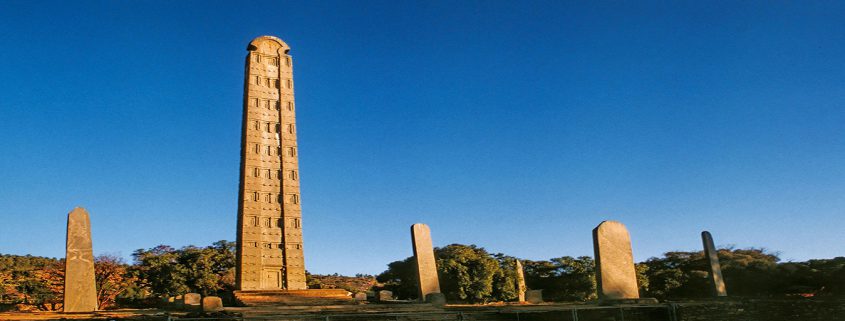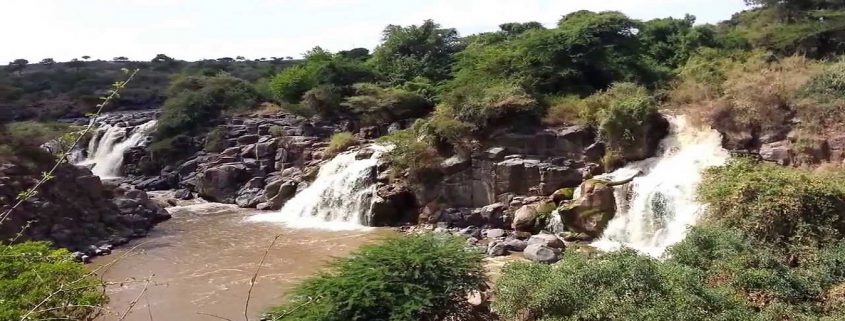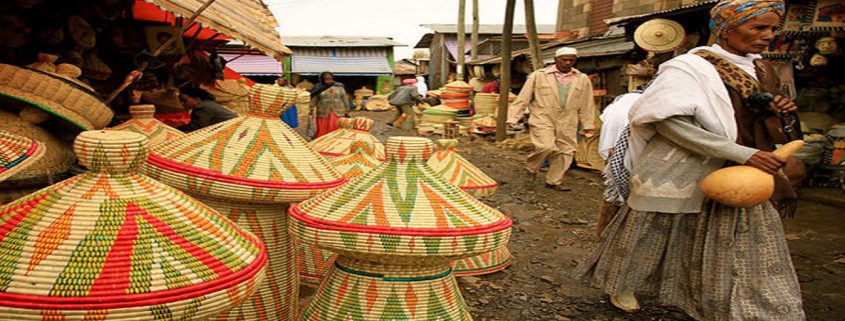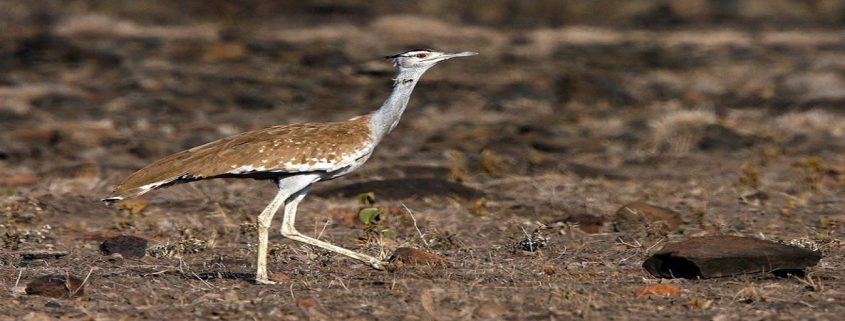Addis Ababa is a city located in central Ethiopia, with a population of around 3,384,569 people. Its elevation is ~2,355m/~7,726ft.
The location of Addis Ababa was chosen as a place to live in by the Empress Taytu Betul, and the city was founded by the Emperor Menelik II in 1887. It has only been the capital of Ethiopia since the late 19th century; before it the capital was Entoto.
The name Addis Ababa means “New flower” in Amharic and was given this name by Empress Taytu Betul. In 1905, the Emperor Menelik imported a large number of eucalyptus trees, which he planted along the streets of the city – these are still visible today.
Today, Addis Ababa is the capital of Ethiopia. It is split into 10 subcities and 99 wards. Addis Ababa is also the headquarters of the African Union and the United Nations Economic Commission for Africa. Ethiopia’s official airline, Ethiopian Airlines, has its main headquarters at Bole International Airport in Addis Ababa. From this airport you can fly to different places in Ethiopia, like Lalibela or Gondar, and also internationally. Addis Ababa is often referred to as the political capital of Africa because of its historical, diplomatic, and political significance for the continent.
Addis Ababa is rich in places to visit. Some of the notable buildings include St. George’s Cathedral, which was founded in 1896, the Holy Trinity Cathedral, which was once the largest Ethiopian Orthodox Cathedral, and the burial site of the Emperor Haile Selassie, who was buried in November 2000. You can also visit the fossilised skeleton of Lucy, one of the earliest known hominids, and a plaster replica of her at the Ethiopian National Museum. In Amharic, Lucy is known as Dinkinesh which means “You are marvelous”.
Other things Addis Ababa has to offer is the Mercato market, the largest open air market in Africa, the Entoto Mountains,Africa Park, and Meskel Square. The Meskel Square is the place in which thousands gather annually on Meskerem 17th (September 27th in the Gregorian calendar), for the Meskel Festival. The Meskel Festival (Amharic:) is a festival with processions and celebrations. A burning pyramid is set in the centre of the square, and set alight by priests. The pyramid is kept alight until the morning, after the night celebrations have ended.
Addis Ababa University, founded in 1950, is home to the Institute of Ethiopian Studies and the Ethnological Museum.
Attractions
St George’s Cathedral:–St George’s Cathedral (Giorgis Cathedral). lies at the north end of Churchill Rd. Built in 1896 in the traditional octagonal shape to commemorate Ethiopia’s victory over the Italians at the Battle of Adwa, the Cathedral houses the work of Afewerk Tekle, the renowned Ethiopian artist responsible for the stained glass windows of the Africa Hall. Cathedral opens 0800-0900 and 1200-1400. There is a small museum in the compound.
The Menelik Mausoleum: –The Menelik Mausoleum, built in 1941 to serve as the tombs of emperors and princes, and the Trinity Cathedral, are located nearby St. George’s. The Trinity Cathedral was built to commemorate Ethiopia’s liberation from five years of Italian occupation.
National Museum: –The small National Museum is located at Han St / Kilo crossroads, just north of St Mary’s Church. Guides are the only real source of information, since the exhibits are poorly labelled, but they vary in standard. The exhibits are varied, and include Lucy; the female fossil skeleton found in northeast Ethiopia in 1974, believed to be about three and a half million years old. The museum has an extensive collection of artifacts, some predating the Axumite civilization of Tigre. It also includes a selection of the more than 200 designs of crosses found in Ethiopia. It is open from 0830-1230 and 1330-1730.––Near the museum are the Lion Cages, probably the only place in Ethiopia to see the Abyssinian lion. The cages are probably best not visited by animal lovers.
Ethiopian Ethnological Museum. A fascinating museum with exhibits relating to the history and culture of Ethiopia. There are many displays of the various ethnic groups found in Ethiopia with information about each of their lifestyles. A large amount of ethnic outfits, instruments, tools, and other artifacts accompany each ethnic exhibit, making it one of the most interesting museums in the city.
Addis Ababa Museum. While the national museum houses artifacts from all over Ethiopia, this museum focuses solely on artifacts and exhibits from Addis Ababa. The building itself was once a palace where Ras Biru Habte-Gabriel, a former Minister of War, resided.
Holy Trinity Cathedral. It was once the largest Ethiopian Orthodox Cathedral. It was built to commemorate the country’s liberation from the Italians, and many victims killed by the Italians during occupation are buried here. The locals call the church *Haile Selassie Church, because Emperor Haile Selassie’s body was moved here in 2000.
Menelik IISquare:
In Menelik II Square stands the imposing equestrian statue of Emperor Menelik II, the victor of Adawa. The statue was erected by Emperor Haile Selassie and dedicated on the day before his coronation in 1930, in memory of his great predecessor. The square is located outside the main gates of St. George Cathedral (Genete Tsige Menagesha Kidus Giorgis), and is close to City Hall. The distance markers on all the highways in Ethiopia mark the distance to their location from the base of the statue of Emperor Menelik II in this Square. Every year, on the anniversary of the victory of the Battle of Adawa, the Emperor would lay a wreath at this statue after attending mass at St. George Cathedral (the victory had occurred on St. George’s Day). Col. Mengistu continued laying a wreath here on the anniversary, but did not attend the church services as his regime was Marxist.
Yekatit 12 Martyrs Square (Sidist Kilo): The Yekatit 12 Square (Sidist Kilo) monument stands in tribute to the thousands of innocent martyrs butchered by the Fascist Italian Occupiers on that date in in the Ethiopian Calender year of 1929 (1936 Gregorian Calendar). The massacre took place at the order of the Italian Vice-Roy Marshal Grazziani in response to an assassination attempt against him carried out by two pro-Ethiopia Eritreans. The monument is shown here during a religious procession of priests of the Orthodox Church, probably at Timkat (Epiphany). Wreaths were laid here by the Emperor to commemorate the massacre every year. Col. Mengistu Haile Mariam continued this practice during his rule, but for a time after the fall of the Dergue regime, only the Mayor of Addis carried out this practice. Recently, the President of the Federal Republic has taken over this task. The monument is in the form of a white obelisk with black bas reliefs of scenes of the massacre as well as scenes of the Imperial funeral accorded to the remains of the victims in the presence of the Emperor following the liberation around it. A Lion of Judah also decorates the face of the obelisk. Even though the image of the Lion of Judah and the Emperor Haile Selassie were removed from all over the city during the reign of the Dergue, they suprisingly did not touch this monument. The monument stands in the Sidist Kilo square infront of the Yekatit 12 Hospital (formerly Emperor Haile Selassie Hospital and known before that as the Beite Saida Hospital). Also facing the square are the southern gates of the Guenete Leul Palace, which today is the main campus of the Addis Ababa University (formerly Haile Selassie I University). Another major attraction adjoining the square is the old Imperial Lion Zoo, where many of the old Imperial lions and their decendents live. The Churches of Menbere Leul Kidus Markos (Altar of Princes St. Marks Church) and the Meskia Hazunan Medhane Alem are both nearby, as are the former palaces of the Crown Prince (later the Political Cadre’s College during the Dergue Era), the Duke of Harrar (later the Headquarters of the Womens wing of the Workers Party of Ethiopia), and Princess Tenagnework (later the headquarters of the Ethiopian Navy), as well as the American and Greek Embassies.
Meyazia 27 Square (Arat Kilo): Meyazia 27 Square is the official name of what is popularly known as Arat Kilo, a name that applies both to the square and the surrounding district of the city of Addis Ababa. The monument at the heart of the Square commemorates the victory over the fascist Italian invaders, and the struggle that preceded it (Meyazia 27 on the Ethiopian Calendar, May 5th on the Gregorian Calendar, is both the day that Addis Ababa was occupied by the Fascists, as well as the day that Emperor Haile Selassie returned to his capital in triumph exactly 5 years later). The original monument includes a relief of the Emperor Haile Selassie holding the national flag, which was altered during the reign of the Dergue regime into a representation of a guerrilla fighter holding the national flag. The EPRDF regime that deposed the Dergue restored the Emperor’s face to the monument. The central obelisk, topped by a Lion of Judah, actually predates the fascist occupation, and the surrounding circle of relief figures and monumental panels was added after the war. The Arat Kilo monument stands at the heart of Addis Ababa’s government district, and in front of the Ministry of Education building (not shown here). Holy Trinity Cathedral (whose dome can be seen in the background) and the Parliament building are nearby, as are the present office of the Prime Minister and the Imperial Palace. Also nearby are the Science College, the Holy Trinity Theological college, Emperor Menelik II High School and the Berhan Ena Selam Printing Press. Foreign Heads of State customarily lay a wreath at this monument during state visits. This square was the focus of Victory Day celebrations held on May 5th (Meyazia 27) every year when the Emperor would lay a wreath here following his attendance at Mass at Meskia Hazunan Medhane Alem Church (Church of the Savior of the World, Consoler of the Grieved). The Dergue regime changed the date of Victory Day to the day that General Cunningham and his British, South African and Nigerian Troops actually entered the city. The post Dergue government in Ethiopia has restored
Abune Petros Memorial: Just West of Addis Ababa’s impressive City Hall, down the hill on the main road to the Merkato district is Abune Petros Square with it’s imposing statue. Abune Petros, the Ethiopian Orthodox Bishop of Wello who was executed by the Italians at the edge of this very square. Abune Petros was one of the four first native Ethiopians who were anointed as bishops by the Coptic Patriarch of Alexandria to serve under the Coptic born Archbishop Abune Kerllos of Ethiopia in 1932. Abune Petros was given the province of Wello as his diocese. In 1936, the Fascist armies of Benito Mussolini occupied much of Ethiopia, and Abune Petros traveled to the northern Shewan district of Menz to join the sons of Ras Kassa, Dejazmatches Wondwossen, Abera and Asfa Wossen Kassa and other resistance leaders to plan an attack on the Italians to drive them out of Addis Ababa. The attack failed in 1937, and the Bishop was captured. Defiantly refusing to submit to Italian rule, he was condemned to death. Shortly before his execution Abune Petros Bishop of Wello, dressed in his clerical robes, held up his hand cross and pronounced his anathema on the people and on the very earth of Ethiopia itself, if they were ever to submit to the invader. He was then shot to death in front of a horrified audience. Emperor Haile Selassie had the statue erected in the memory of this great Bishop upon his restoration to the throne. The spot of his execution on the western edge of this square is also marked by a memorial slab. Sadly, during the brutal rule of the Dergue regime, the bodies of many victims of the “Red Terror” were displayed in this square.
Mercato:–The Mercato is located in western Addis Ababa and is one of the largest markets in Africa offering an array of colors, aromas, costumes, produce and jewellery. Beware of pickpockets. In Mercato virtually every possible commodity is on sale, from livestock to computers.
Entity is the mountain range that rises to the north of Addis and is easily accessible from the city. This is where Menelik started his first capital, and the Church of Entonto Mariam where he was crowned can still be visited At the top of the hill is the Church of Entonto Raguel which offers stunning views.




